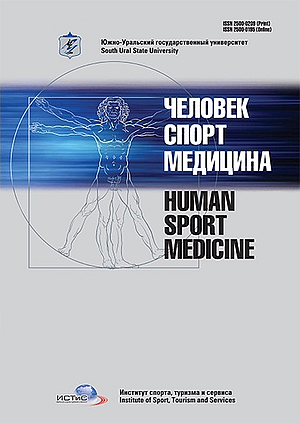JUSTIFICATION OF EFFECTIVENESS OF A DESIGNED HEALTH-FORMING EDUCATION SPACE IN SCHOOL BASED ON SPORTIZATION OF PHYSICAL EDUCATION
Keywords:
sportization of physical education, secondary education human subjects, school students, health forming, metasubject health-forming competences, respiratory function parameters.
Abstract
Aim. In the paper, based on key methodological principles of system, eco-psychological, competence and meta-subject approaches, the authors justify the conception of healthforming educational space of modern comprehensive school the core of which may be the system of sportized physical education. The paper also provides an experimental justification of effectiveness of implementation of the stated concept. Organization and Methods. The main methods of research are analysis and synthesis, educational modelling, transforming educational experiment, survey, and testing. The experimental work aimed to reveal the effectiveness of the implemented model of health-forming space was conducted at the premises of schools № 45 and № 118 of Chelyabinsk, and schools № 1 and № 11 of Korkino (Chelyabinsk region). Results. The paper gives the extended conceptual construct of metasubject and competence theoretical competences due to justified understanding of key health-forming competences. The paper presents designed integrative criteria of assessment of health and levels of metasubject and health-forming competences in students which may be used in the educational practice. Systemized and justified direction of relationships of education human subjects within health-forming activity guides the implementation of educational interaction with students and their parents. Conclusion. The structure of health-forming educational space in school is presented with physical and anthropo-sociogenic subspaces which due to system-forming (sportization of physical education) and system-conditioning (intersubject integration) chronotopes actualizing temporal and spatial relations interact and form the subspace of humane-personal interaction saturated with health-forming values, traditions and techniques. The conditions required for implementation of sportized physical education technology are: first, module-based structure of educational material for PE lesson based on kinds of sports; second, differentiation of the physical load considering individual mental and physiological peculiarities of students at lessons for better motivation, goal-setting and training effect; third, consolidation of in-lesson and out-lesson activity organization which means the consistency of principles, content, and forms of sportization; fourth, extended forms of extracurricular work and its increased effectiveness due to uniting several schools in one interschool sports club.References
1. Bakhtin M. Voprosyliteratury i estetiki. Issledovaniya raznykh let [Voprosyliteratury and Aesthetics. Research from Different Years]. Moscow, Literature Publ., 1975. 504 p.
2. Lishin O.V., Chernysheva O.A., Yashchuk S.L. [Teen in School. A System of Relations, Motivation Activities]. Mir psikhologii [World of Psychology], 2001, no. 3, pp. 233–246. (in Russ.)
3. Manzheley I.V., Ivanova S.V. [Organization of Physical Training and Sports Activities in the Community in the Metro Area]. Teoriya i praktika fizicheskoy kul'tury [Theory and Practice of Physical Culture], 2013, no. 2, pp. 42–47. (in Russ.)
4. Minkovskiy G. Prostranstvo i vremya [Space and Time]. Moscow, Atomizdat Publ., 1973. pp. 167–180. (in Russ.)
5. Ukhtomskiy A.A. Dominanta [Dominanta]. St. Petersburg, Peter Publ., 2002. 448 p.
6. Khasanov I.A. Vremya kak ob"ektivno-sub"ektivnyy fenomen [Time as Objectively-Subjective Phenomenon]. Moscow, Progress-Tradition Publ., 2011. 328 p.
7. Cherepov E.A., Nenasheva A.V. [The Current State of Physical Education in Russia. The Heart of the Problem and Ways to Improve]. Bulletin of South Ural State University. Ser. Education, Healthcare Service, Physical Education, 2014, vol. 14, no. 3, pp. 5–19. (in Russ.)
8. Shendrik I.G. [Design and Innovation Processes in Education]. Obrazovanie i nauka: Izvestiya Ural'skogo otdeleniya Rossiyskoy akademii obrazovaniya [Education and Science. Proceedings of the Ural Branch of the Russian Academy of Education], 2000, no. 3, pp. 74–85. (in Russ.)
9. Bergson H. Introduction a la Metaphysique. La Penseeet le Mouvant. Paris, 1966. 181 p.
10. Bourdieu P., Reynaud J.D. Unesociologie De L'actionestelle Possible? Revue Francaise De Sociologie. Annee, 1966, vol. 7, no. 4, pp. 508–517.
11. Gibson J. The Ecological Approach to Visual Perception. Boston, Houghton Mifflin, 1979; Psychology Press, 1986. 315 p.
2. Lishin O.V., Chernysheva O.A., Yashchuk S.L. [Teen in School. A System of Relations, Motivation Activities]. Mir psikhologii [World of Psychology], 2001, no. 3, pp. 233–246. (in Russ.)
3. Manzheley I.V., Ivanova S.V. [Organization of Physical Training and Sports Activities in the Community in the Metro Area]. Teoriya i praktika fizicheskoy kul'tury [Theory and Practice of Physical Culture], 2013, no. 2, pp. 42–47. (in Russ.)
4. Minkovskiy G. Prostranstvo i vremya [Space and Time]. Moscow, Atomizdat Publ., 1973. pp. 167–180. (in Russ.)
5. Ukhtomskiy A.A. Dominanta [Dominanta]. St. Petersburg, Peter Publ., 2002. 448 p.
6. Khasanov I.A. Vremya kak ob"ektivno-sub"ektivnyy fenomen [Time as Objectively-Subjective Phenomenon]. Moscow, Progress-Tradition Publ., 2011. 328 p.
7. Cherepov E.A., Nenasheva A.V. [The Current State of Physical Education in Russia. The Heart of the Problem and Ways to Improve]. Bulletin of South Ural State University. Ser. Education, Healthcare Service, Physical Education, 2014, vol. 14, no. 3, pp. 5–19. (in Russ.)
8. Shendrik I.G. [Design and Innovation Processes in Education]. Obrazovanie i nauka: Izvestiya Ural'skogo otdeleniya Rossiyskoy akademii obrazovaniya [Education and Science. Proceedings of the Ural Branch of the Russian Academy of Education], 2000, no. 3, pp. 74–85. (in Russ.)
9. Bergson H. Introduction a la Metaphysique. La Penseeet le Mouvant. Paris, 1966. 181 p.
10. Bourdieu P., Reynaud J.D. Unesociologie De L'actionestelle Possible? Revue Francaise De Sociologie. Annee, 1966, vol. 7, no. 4, pp. 508–517.
11. Gibson J. The Ecological Approach to Visual Perception. Boston, Houghton Mifflin, 1979; Psychology Press, 1986. 315 p.
References on translit
Published
2016-06-01
How to Cite
Lubysheva, L., & Cherepov, E. (2016). JUSTIFICATION OF EFFECTIVENESS OF A DESIGNED HEALTH-FORMING EDUCATION SPACE IN SCHOOL BASED ON SPORTIZATION OF PHYSICAL EDUCATION. Human. Sport. Medicine, 16(2), 52-61. https://doi.org/10.14529/hsm160205
Issue
Section
Sports training
Copyright (c) 2019 Human. Sport. Medicine

This work is licensed under a Creative Commons Attribution-NonCommercial-NoDerivatives 4.0 International License.















